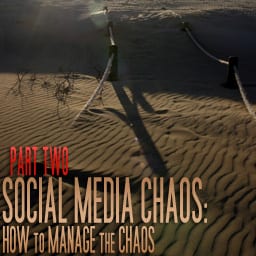Part 2: Social Media Chaos: How To Manage The Chaos

This is Part 2 of our 2-Part series on Social Media Chaos.
In “Part 1: Social Media Chaos: The Shifting Sands of the Business Landscape”, we present the chaotic marketing environment created by social media.
To recap the last few paragraphs of Part 1, here’s how companies fall victim to hasty mistakes in each of the three Acts of Social Media Chaos:
- While hurrying to catch up in social media, companies pass over careful planning, instead flinging themselves into the social media fray without checking to see which channels are right for them, which can be left out, and whether or not they’re reaching their audience.
- Companies struggling with social media talent find themselves rapidly switching from one strategy to another as leadership changes, or else never settling upon a social media strategy that works for their business.
- Measuring the success of social media with the same ol’ marketing metrics is a little like trying to measure the width of a canyon using a speedometer. Companies not only need to rethink marketing strategies, they also have to rethink how they will measure social media success.
How to Manage the (Social Media) Chaos
As we stated in Part 1, the chaotic marketing environment created by social media can still be navigated by the savvy marketing professional. Here’s six tips for managing the chaos.
- Good social media may look spontaneous, but organization is still a must. Altimeter Group, a research-based consulting firm, found many large corporations managing an average of 178 social media accounts. As a result, businesses are struggling to coordinate their marketing message across different channels and prevent brand fragmentation. Social media management software is emerging to help businesses manage these various accounts; your marketing department would be wise to invest in a tool like this to assist with organizing, tracking, and measuring social media campaigns.
- Live in the present, look to the future. They say that those who don’t know history are bound to repeat it. When websites came on the marketing scene, too many businesses wrote them off at first – exactly as many would later write off Facebook, Twitter, blogging, and YouTube. Don’t make the same mistake three times: Make sure your social maedia marketing team lives in the present, not the past, while it simultaneously keeps an eye on the future.
- Speaking of the future, look at your mobile device. Smartphones are no longer the next “big thing;” smartphones are a big thing that’s already here. What is your company doing to reach out to mobile users, especially social media mobile users? How have you optimized your website for them? How are you making your brand a part of their on-the-go lifestyle? If you don’t have answers to these questions, you need to find them quickly.
- Got talent? Get it. Marketers very much need to either recruit or create social media talent within their organizations. However, the next generation of (social media) marketers that you build should be defined by their creativity, curiosity, and flexibility, not just a simple checklist of computer skills. For example, you don’t just want a Facebook wiz; you want someone who can envision a post-Facebook world – because the time will eventually come, perhaps sooner than any of us can guess, when Facebook will become MySpace and some new network will reign supreme.
- Be brave enough not to imitate. You may feel safe by looking at what a successful competitor is doing in social media and imitating their model. Yet remember what your mother asked you all those years ago about copying your friends: “If your friend jumped off a bridge, would you?” Indeed, many companies have jumped (or were pushed) off bridges in the last several years. The iPhone and Droid dethroned Nokia; online video streaming and Roku boxes stopped the meteoric rise of Netflix. Follow the advice in tip #4 and succeed without being a copycat.
 Remember Charles Darwin. Charles Darwin observed that it wasn’t necessarily the strongest or smartest species that survives a challenging time; it is the species that is most capable of adapting. If we could boil “Social Media Chaos” down into one statement, it would be this single, astute observation.
Remember Charles Darwin. Charles Darwin observed that it wasn’t necessarily the strongest or smartest species that survives a challenging time; it is the species that is most capable of adapting. If we could boil “Social Media Chaos” down into one statement, it would be this single, astute observation.
This is Part 2 of our 2-Part Social Media Chaos Series.
In “Part 1: Social Media Chaos: The Shifting Sands of the Business Landscape”, we present the chaotic marketing environment created by social media.







